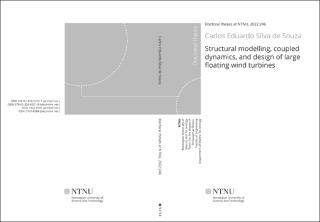| dc.contributor.advisor | Bachynski-Polić, Erin | |
| dc.contributor.advisor | Gao, Zhen | |
| dc.contributor.author | de Souza, Carlos Eduardo Silva | |
| dc.date.accessioned | 2022-09-14T08:18:38Z | |
| dc.date.available | 2022-09-14T08:18:38Z | |
| dc.date.issued | 2022 | |
| dc.identifier.isbn | 978-82-326-6551-8 | |
| dc.identifier.issn | 2703-8084 | |
| dc.identifier.uri | https://hdl.handle.net/11250/3017723 | |
| dc.description.abstract | Floating wind turbines (FWTs) are expected to contribute significantly in the transition to a low-carbon economy. In addition to their increased competitiveness for water depths higher than 50-60 m, FWTs may also benefit of the offshore wind trend of increased turbine dimensions, considering the potential improvements in the cost-effectiveness of support structures.
A better understanding of modelling approaches, coupled dynamics, design, and analysis is still needed, however, to improve their cost-effectiveness and maximize the energy produced by each unit. This thesis approaches relevant topics for the design and analysis of the next generation of FWTs, namely platform-rotor-controller coupled dynamics; modelling of flexible platforms; control strategies; and design considerations.
Changes in the surge and pitch natural periods of FWTs, operating under constant wind speed, previously reported by independent publications, were further investigated. Although well captured in fully-coupled analyses, the effect had not been explained previously, preventing its quantification at conceptual design stages. Nonlinearities in the mooring system due to the platform mean displacement are found to explain the phenomenon for the surge motions. For pitch, the effect is linked to the coupling between platform motions, rotor dynamics, and control system.
In particular, the relative phase between the nacelle motions and the ensuing fluctuations in the rotor thrust allows the dynamic thrust to be decomposed into apparent inertia and damping effects, which depend on the motion frequency, incident wind velocity, and controller configuration. The notion of a frequency-dependent aerodynamic damping coefficient is shown to be relevant in frequency-domain FWT analyses, which often assume a constant damping coefficient. The latter is demonstrated to be non-conservative in terms of pitch motions and tower loads.
Modelling of FWT platforms as flexible structures is also studied due to the expected importance for larger FWTs - both on their global dynamics and on local structural analyses of the platform. For a 5 MW tension-leg platform wind turbine (TLPWT), the platform (pontoon) elasticity significantly affects the platform global motions, as well as the 1st tower bending natural frequency. Hydroelasticity associated with the pontoons' deflections is also assessed, and found to be negligible compared with the radiation loads associated with the rigid-body modes.
Hull elasticity is also modelled for 20 MW spar-type FWTs. In this case, the focus is on the method adopted to distribute hydrodynamics loads. The adoption of potential theory results in lower fatigue damage than a formulation based on Morison's equation. A non-negligible reduction in the first tower bending frequency, due to the platform flexibility, was also observed.
Strategies to avoid instabilities associated with controller-motion interactions are also assessed. The common approach of detuning the blade-pitch controller gains is shown to be inadequate for large FWTs, which tend to have longer pitch natural periods and thus require excessive reduction of the controller frequency. Other methods, which include the nacelle velocity in the control logic, are also evaluated. Based on a coupled platform-rotor model, simple feedback of the nacelle velocity to the control law is shown to be problematic in terms of instability, especially when a low-pass filter is applied to the signal. Nacelle velocity feedforward, on the other hand, ensures stability even in the presence of the filter and when hydrodynamic damping is disregarded. A method for tuning the controller using these strategies is also provided.
Finally, design and analysis paradigms for large FWTs are evaluated through the design of three 20 MW spar-type structures, differing on the static pitch angle under rated thrust. The relative contributions of inertial, gravity, and thrust loads on global dynamics and hull/tower sectional loads are investigated. The hydrostatic restoring in pitch affects fatigue damage and extreme loads significantly. In particular, extreme sectional stresses are shown to be governed by gravity loads associated with the RNA weight, such that load cases associated with the rated wind speed may provoke the extreme loads for some sections at the platform and tower, especially for platforms with lower hydrostatic restoring in pitch. | en_US |
| dc.language.iso | eng | en_US |
| dc.publisher | NTNU | en_US |
| dc.relation.ispartofseries | Doctoral theses at NTNU;2022:246 | |
| dc.relation.haspart | Souza, Carlos Eduardo Silva de; Bachynski, Erin Elizabeth.
Changes in surge and pitch decay periods of floating wind turbines for varying wind speed. Ocean Engineering 2019 ;Volum 180. s. 223-237
https://doi.org/10.1016/j.oceaneng.2019.02.075
This is an open-access article distributed under the terms of the Creative Commons Attribution License (CC BY) | |
| dc.relation.haspart | Souza, Carlos Eduardo Silva de; Bachynski, Erin Elizabeth.
Effects of hull flexibility on the structural dynamics of a TLP floating wind turbine. Journal of Offshore Mechanics and Arctic Engineering (2020), Vol. 142: 011903.
Paper No: OMAE-19-1069 https://doi.org/10.1115/1.4044725 | |
| dc.relation.haspart | Silva de Souza, Carlos Eduardo; Bachynski-Polic, Erin Elizabeth.
Design, structural modeling, control, and performance of 20 MW spar floating wind turbines. Marine Structures 2022 ;Volum 84.
https://doi.org/10.1016/j.marstruc.2022.103182
This is an open-access article distributed under the terms of the Creative Commons Attribution License (CC BY) | |
| dc.relation.haspart | Silva de Souza, Carlos Eduardo; Hegseth, John Marius; Bachynski, Erin Elizabeth.
Frequency-Dependent Aerodynamic Damping and Inertia in Linearized Dynamic Analysis of Floating Wind Turbines. Journal of Physics: Conference Series (JPCS) 2020 ;Volum 1452.
https://doi.org/10.1088/1742-6596/1452/1/012040
Content from this work may be used under the terms of the Creative Commons Attribution 3.0 licence CC-BY | |
| dc.title | Structural Modelling, Coupled Dynamics, and Design of Large Floating Wind Turbines | en_US |
| dc.type | Doctoral thesis | en_US |
| dc.subject.nsi | VDP::Technology: 500::Marine technology: 580 | en_US |
